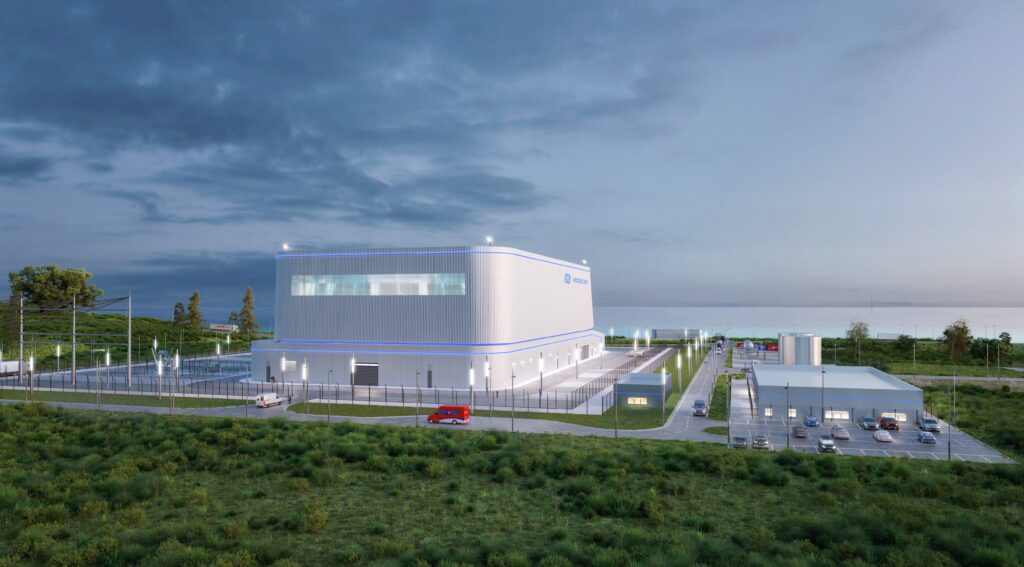Study Finds ‘Advanced Nuclear Is the Clear Winner’ to Replace Comanche Coal-Fired Power Plant
A report published by the Pueblo Innovative Energy Solutions Advisory Committee (PIESAC) says the closure of Comanche Unit 3, a coal-fired power plant capable of generating about 800 MW gross, will have “devastating impacts on the economy of Pueblo unless the community, Xcel Energy, and other stakeholders begin planning now for replacement of the highly paid and highly skilled jobs and tax payments.” Furthermore, the study found “advanced nuclear is the clear winner” as a replacement technology when looking at “jobs, tax payments and a path to the future for Pueblo to prosper.”
Units 1 and 2 at the Comanche Generating Station (Figure 1) were commissioned in 1973 and 1975, respectively. Each had a gross capacity of about 350 MW. Unit 3, with a capacity of about 800 MW gross, was added in 2010. Xcel Energy operates the facility, which has been the largest power plant in Colorado and was recognized as the Powder River Basin Coal Users’ Group (PRBCUG) Plant of the Year in 2018. However, Unit 1 was retired in 2022, Unit 2 will be shuttered in 2025, and Unit 3 is slated for closure in 2031.

The PIESAC cited testimony by Dr. Mike Wakefield, director of the Healy Center at Colorado State University, Pueblo, who reportedly suggested Comanche 3 is one of the most economically impactful industries in the Pueblo community with a total annual impact of more than $196 million a year. In the report, one of the PIESAC members said, “Pueblo is a poor community, and the closure of Comanche 3 puts us further behind.”
Xcel Energy was noted to be one of the largest taxpayers in Pueblo, paying more than $25 million a year to Pueblo County, most of which is reportedly from the Comanche Station with more than $15 million of the total coming from Comanche 3. In addition, Holy Cross Electric and CORE (the other co-owners of Comanche 3) reportedly pay almost $5.9 million a year in taxes to Pueblo County.
After reviewing and studying possible new clean energy technologies that could be available by 2034, the PIESAC recommended that Xcel Energy consider constructing “advanced nuclear including small nuclear modules and or a new combined cycle gas plant with carbon capture” in Pueblo. However, the committee said a new gas plant with carbon capture would not “make Pueblo whole.” The report says, “Of all of the technologies that we studied, only advanced nuclear generation will make Pueblo whole and also provide a path to prosperity.”
Community Support Is High
A poll of 500 individuals from Pueblo was conducted by The Keating Group during the period Nov. 9–14, 2023. The PIESAC report says, “It is clear that the community understands the importance of Comanche 3 to the economic wellbeing of Pueblo.” The Keating Group reportedly found 64% of respondents were “concerned” about the closure of Comanche 3, with a majority of those respondents “very concerned.” Most feared the job losses, but tax losses and economic impacts on the community were also high on the list.
The gas plant with carbon capture received the most support as a replacement technology (74%), but advanced nuclear was not far behind, with about two-thirds of respondents supporting it. The poll also found high support for additional solar, but the PIESAC was less excited about that option because solar produces very few jobs—five to 10—and lower salaries ($40,000 to $80,000). The report says tax payments from solar would only amount to about $1.69 million per year. “Further, Pueblo may have reached the saturation point for solar installations,” it says.
PIESAC History
The PIESAC was created to evaluate and recommend future clean energy generation strategies that decision-makers felt could help direct the replacement of the existing coal units at Comanche Generation Station. The committee was formed from a diverse group of Pueblo community leaders.
PIESAC’s first meeting was held in February 2023. It has met monthly and sometimes twice a month, with meetings lasting approximately three hours. The group has been advised by several independent third parties, including 1898 & Co., which is a national consulting group established by Burns and McDonnell; Tetra Tech; LEEDS School of Business at Colorado University, Boulder; and The Keating Group. Many Xcel Energy leaders have also provided oral presentations and written information to the group.
As part of the evaluation process, PIESAC toured the Comanche plant, as well as a site known as PuebloPlex—a large undeveloped area with roads and rail, which is also a possible site for replacement power generation. PuebloPlex was noted in the report to have “huge potential for energy-related companies.” The group also heard from various community organizations, including the library association and local school districts, which all have receive funds from Comanche’s taxes.
Assessing the Technology
In addition to combined cycle gas turbine (CCGT) and advanced nuclear technology (Figure 2), the PIESAC also evaluated several other energy options based on providing 500 MW of electricity, which is about what Xcel Energy owns of the Comanche 3 unit. The results were “starkly different,” according to the report.

Solar, lithium-ion battery, high-temp battery, flow battery, and kinetic energy were all estimated to require less than 10 long-term employees, and contribute less than $1.75 million in property taxes. Long-duration storage, thermal energy storage, liquid air energy storage, hydrogen primary fuel, and compressed air energy storage all fell in the five to 40 worker range, but each also contributed less than $1.75 million in property taxes. While CCGT with carbon capture was estimated to only require about 20 to 25 workers, it did provide much higher property tax revenue ($16.52 million) than the solar or storage options.
Still, the clear winner, as previously mentioned, was advanced nuclear. It was expected to put about 200 to 300 long-term staff on the payroll, and provide $95.29 million in property taxes. “After all of the presentations and analysis that we have done over the last ten months, we have each become convinced that the only technologies that have the potential to create good long-term family-supporting jobs and millions of dollars of property tax payments are advanced nuclear with a new gas and carbon capture running a distant second,” the report says.
—Aaron Larson is POWER’s executive editor (@POWERmagazine).